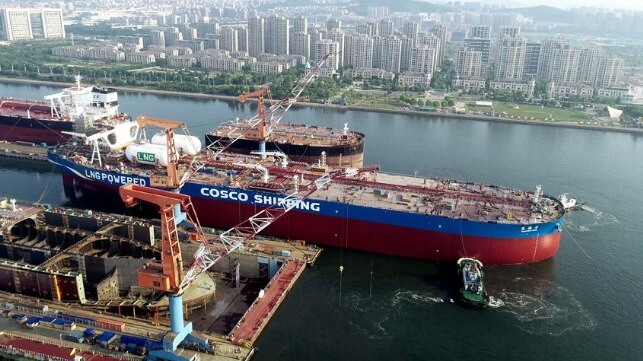SEA-LNG Argues LNG Retrofits Present Best Economic Case with CII Regs

Industry coalition SEA-LNG issued a new report in which it argues that retrofitting in-service vessels to operate on LNG will improve a vessel’s economic life with the IMO’s pending Carbon Intensity Index (CII) which is due to begin phasing in starting later this year. The LNG group presents its business case for retrofits recognizing the higher conversion costs versus scrubbers but contends the result is improved financial viability and protect vessels from becoming stranded assets with their service cut short by the increasing standards in the regulations.
“Retrofitting vessels provides a faster and cheaper route to the lower emission fuels that are essential to reduce shipping emissions," says Adi Aggarwal, General Manager at SEA-LNG.
The group writes in its report that increasingly stringent environmental regulations will drive down the CII grades for existing ships and will have a detrimental effect on charter rates for those powered using fuel oil. They argue the financial viability of vessels that are just a few years old will be under severe threat if significant action to reduce emissions is not taken.
The report looks at a 300,000 dwt VLCC trading from the Arabian Gulf to China. They used the 11,700 nautical mile route to represent the energy trade between the Middle East and China and typical for vessel operations. The options they considered were operating the VLCC on very low sulfur fuel (VLSFO) or installing scrubbers to continue the operation on heavy fuel oil (HFO). Against those options, they looked at retrofitting the traditional vessel to LNG-powered operations.
They recognize the significant upfront costs and premium in the retrofit, which in and of itself appears to rule out the conversion option. They estimate the CAPEX for a project to retrofit a 2-stroke LNG engine, in which the scope of work includes modifications to the 2-stroke engine for LNG fuel, necessary LNG delivery systems, and incorporates a 4,600m3 LNG tank to provide 14,000 nm, range at $30.3 million. The figure is commensurate with the cost cited when Hapag-Lloyd converted its first LNG-ready containership for alternative fuel operations in 2020-2021.
By comparison, they estimate the cost of a 91-day conversion for a tanker to retrofit open-loop scrubbers for the 2-stroke HFO engine. That project is set at $4.7 million and in both estimates they include the cost of lost revenue during the conversion period.
The payback comes in the ability to extend the earning power and life of the vessel. SEA-LNG’s analysis says that the LNG-fueled VLCC could maintain a B rating in the CII scheme before falling to C in mid-2027 and finally slipping to D in 2032. The vessel operating on HFO with the scrubber they propose would start with a C ranking, failing to D by 2023, and to E by mid-2028. Similarly, low sulfur fuel operations would slip to a D by 2025 and E by 2030.
“The HFO scrubber faces imminent danger of becoming obsolete… Standing for the VLSFO-compliant vessel is delayed by two years to 2025….The LNG retrofit is future-proofed as the CII scoring fares much better than other alternatives considered in the study,” according to the report.
They believe the VLCC retrofitted for LNG fuel enjoys a commercial financial advantage in chartering with a CII rating one or more grades above the other options. “This analysis concludes that retrofitting LNG as a marine fuel potentially delivers strong investment returns over the remaining 10-year trading life of the VLCC, with returns dependent upon the relative fuel prices of LNG, HFO, and VLSFO.”
Based on the volatility of the price of the different fuel options, the report gives the reader the ability to adjust assumptions based on their projections for fuel prices. Fuel, of course, is a major consideration as LNG prices are at near record highs. The current price has prompted some dual-fuel ships to revert to traditional fuels over LNG, while the report gives the reader the ability to adjust fuel prices over the assumed 10-year horizon. SEA-LNG also points to the potential benefits of bioLNG as a drop-in blend to improve compliance but leaves consideration of the impact of slow steaming for another report.
The group also sees future benefits as the industry moves towards retrofits including declining costs for the conversions. They also point out that with long waiting times in the shipbuilding sector conversions present a quicker route to maintain fleet capacity while achieving compliance. The report (available online) concludes that LNG retrofits future-proof assets against both planned environmental regulations and new climate-related measures, such as carbon pricing for shipping.
